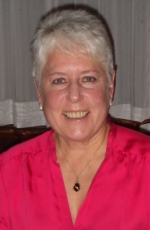 Aileen Stalker is the author of The One and Only Sam: A Story Explaining Idioms for Children with Asperger Syndrome and Other Communication Difficulties published by Jessica Kingsley Publishers. She is an experienced occupational therapist with a Masters degree in special education, and has over 30 years’ experience of assessing and treating children with a wide variety of diagnoses and has presented papers at numerous conferences, developed handbooks and manuals for clinical therapeutic use and worked at a senior level in several Occupational Therapy departments.
Aileen Stalker is the author of The One and Only Sam: A Story Explaining Idioms for Children with Asperger Syndrome and Other Communication Difficulties published by Jessica Kingsley Publishers. She is an experienced occupational therapist with a Masters degree in special education, and has over 30 years’ experience of assessing and treating children with a wide variety of diagnoses and has presented papers at numerous conferences, developed handbooks and manuals for clinical therapeutic use and worked at a senior level in several Occupational Therapy departments.
What inspired you to write The One and Only Sam?
During all my years of working with children, and also raising my own two sons, I observed how children enjoy stories and are especially intrigued by silly language. When I gained additional training and began to tutor children with dyslexia, and also working with children with high functioning autism in social skills groups – many of whom struggle with the abstract ideas embedded in the words of an idiom – it was a natural choice to include a section about “silly sayings” within the tutoring sessions or the group activities.
The use of pictures (which I drew) to illustrate “what it sounds like” and “what it really means,” also helped the children to gain better understanding of the idioms. But I also realized that any child understands language better if it has context and relates to their own experiences. So developing the story about Sam trying to understand idioms that he heard in his everyday life grew out of my clinical practice and the needs I saw that were not met by the idiom books that were already on the market. I was lucky to also have an artistic friend who was very skilled in creating the whimsical drawings.
You have had a long and varied career working with children with autism, ADHD, challenging behaviour and physical disabilities. What have you found most rewarding?
My most rewarding career was raising my own two sons who are wonderful, caring young men. Professionally however, I think seeing the resiliency in children, many of whom had experiences that would devastate most adults, but who were able to still play, learn and try again, and often, with the help of a multi-disciplinary team approach, overcome their initial negative start in life.
Do you have any advice for people starting work in Occupational Therapy or special education?
I think following your passion is important throughout your career. Both Occupational Therapy and special education offer endless possibilities to make use of your own interests as well as responding to the needs of the individual with whom you are working. I often think that if special education had existed in its current form when I taught for the one year before taking Occupational Therapy training, that I might have continued to work in the educational system. However, having shifted to Occupational Therapy, I spent a wonderful lifetime career both teaching children and working with educators, parents and researchers so I ended up with the best of both worlds. I was also able to use my interest in art, writing, story-telling, cooking and use of media and physical activities as therapeutic approaches.
What do you think are the biggest challenges faced by children with autism spectrum conditions?
I think the loneliness that young children and pre-teens experience (no matter how much intervention occurs and/or education of peers to help their understanding of why the child with ASD has certain behaviours) when they don’t really understand yet what it is that makes them the unique individual that they are, is very heart-breaking. However, in the social skills/social thinking groups that I co-led for six years I saw the benefit of not only teaching the reasoning behind social thinking but also the benefit of having like children together. Generally each of the children could find another child in the group who was “just like me” and this at last gave them affirmation that they could have a friend and this decreased their loneliness and isolation in the social world.
What are you reading at the moment?
Well, I have officially retired as a practicing Occupational Therapist but that OT perspective of maintaining a balanced life that has meaning and purpose, will stay with me forever. Now I am focusing on physical activity, writing and doing more drawing, watercolours and print-making, and of course lots of reading and fun with friends and family and my new grand-daughter.
I am always thinking about new books to write as well as read. Presently I am reading A Walk in the Woods by Bill Bryson (an amusing follow-up to a five day backpack trip I did this summer), Saving Fish from Drowning by Amy Tan and also looking at a hiking book for New Zealand (where I will be hiking and back-packing for 7 weeks in 2010.) I am also reading a book about public art in Canada as current background information for the talks I am giving for a recent book I co-authored called Public Art in Vancouver: Angel Among Lions.
Copyright © Jessica Kingsley Publishers 2009.
The One and Only Sam: A Story Explaining Idioms for Children with Asperger Syndrome and Other Communication Difficulties is released this month and is available to order.